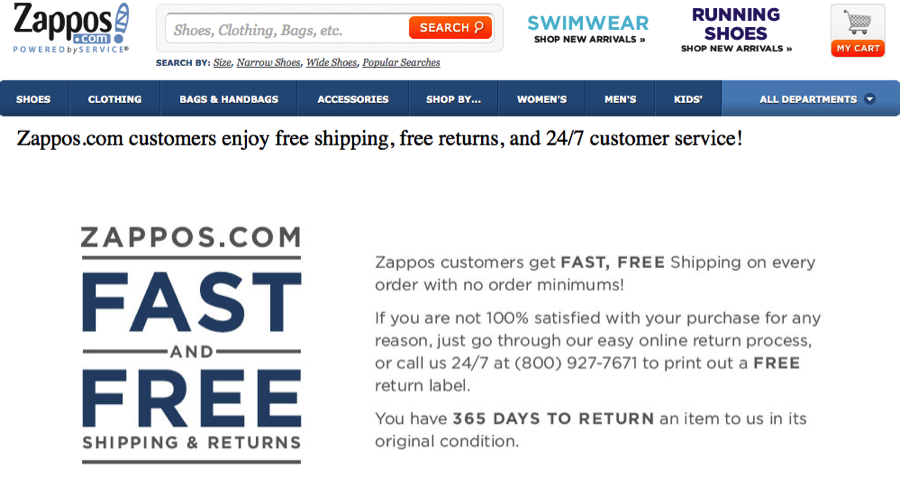Returns. I hate them. You hate them.
Returns are the bane of an eCommerce retailer’s existence and a royal pain for online shoppers. In many ways, returns are a lose-lose proposition for both parties. Returns are perceived as a bit more difficult in an eCommerce transaction, since the shopper can’t just physically return their item down the street to a brick and mortar store and get their money back instantly.
With careful positioning and thought about how returns are handled, return policies can be a definitive positive selling advantage for retailers and a point of assurance for shoppers.
Before we discuss how returns can be used to actually sell more, let’s look at this problem from two perspectives.
Questions from an online shopper’s standpoint
- One of the first questions to enter a shopper’s mind is, “Can I return this?”
- Do I have to pay for return shipping?
- How long will it take to receive my refund or exchange?
- What if this item isn’t the right size?
- What if this item just isn’t what I was expecting?
From an eCommerce retailer’s standpoint
- Often, retailers may prolong issuing a refund until the last possible moment to preserve cash flow.
- Returns impact accounting and SKU inventory management.
- Returns require more administrative time to manage.
Returns are a big stumbling point in the digital retail space. Shoppers want to know they have recourse and options when purchasing a product if they are disappointed. Even with options, there can be several reasons a customer wants to initiate a return.
Let’s look at reasons why a shopper may return an item
- General disappointment upon receiving the item, it’s just not what they expected.
- Item dimension aren’t accurate.
- The item looks different than the online photos.
- Product isn’t compatible with needed accessories.
Industry statistics shed even more light on the state of returns in the online retail industry. source: eMarketer, Salescycle.
- 2 out of 3 shoppers would purchase more online if returns were free.
- 24% of shoppers will abandon their shopping cart if return policies are not clearly stated.
There are things however, retailers can do to minimize returns and keep shoppers happy.
There is a direct correlation between quality eCommerce site content and a retailer’s confidence offering a stellar return policy. The more informative a particular SKU product description page is, the less likely a shopper will feel as if they were misled. You may ask, how can a retailer improve their product page in order to mitigate the quantity of returns?
Let’s look at a few ways
- Provide excellent product descriptions, which go beyond stock manufacturer content.
- Ensure all product dimension specifications are accurate and easy to find.
- Encourage product reviews from shoppers via post purchase trigger emails.
- Use high quality product photography with multiple angles and zoom capabilities.
- If possible, use a product demonstration video.
- Include a section for product accessory compatibility (if applicable).
- Make your return policy easy to find and comprehend.
Let’s look at a quote from the CEO of Zappos, Craig Adkins.
“Our best customers have the highest returns rates, but they are also the ones that spend the most money with us and are our most profitable customers. Zappos’ modus operandi is not to give its purchasers the cheapest footwear on the block, but to give them the best service: hence, a 365-day returns policy, and free two-way shipping.”
Additionally, consider an email survey to shoppers who returned a product. Keeping a digital record of reasons can help build a reference point as to why returns are happening over time and provide insight for improving overall policies and/or product specific content.
If an eCommerce retailer has accomplished most of these product page enhancements listed above, there is one other strategy, which can yield a huge impact. This strategy may seem controversial. It may make you stand apart from other competitors in your market niche, and that’s a good thing.
If the above tactics are implemented, chances are a retailer can present themselves as higher quality than their competitors and charge a bit more for each product, thus allowing for higher margins per SKU.
Consider offering not only FREE returns, but for a time frame longer than commonly used. If you were personally shopping for a product and were presented with two retailer return options, which would you choose?
Retailer A: “We accept returns for 30 days after purchase.”
Retailer B: “6 month free returns policy. Guaranteed.”
If you were Retailer B, and broadcasted this unique selling proposition across your entire shop and all marketing materials, do you think it would generate a higher quantity of completed purchases?
Chances are, most shoppers will NOT take full advantage of this type of policy. Usually, shoppers are most excited (or dissatisfied) about a product when it’s new and just arrived. As we all know, over time newness fades and our attention shifts to other things in our busy daily lives.
Depending upon the specific niche a retailer is in, various other tactics can be used to minimize returns. For example a fashion retailer can use a virtual sizing/fitting application. A furniture retailer can use a virtual room application to create a more immersive way to experience room placements before the product purchase. The retailer Glasses Direct, who sells eyeglasses, allows shoppers to purchase items on a trial basis.
All excellent ideas!
Given the simple strategies presented in this article to reduce shopper returns, how does your return policy add up?
About The Author
Jeff Bronson is the founder of eCommerce Warriors, creating profitable eCommerce strategies for Body, Mind & Spirit retailers. With over 11 years experience, Jeff has both owned a specialty online retail shop and served as Director of Digital Strategy for a well known digital agency.


